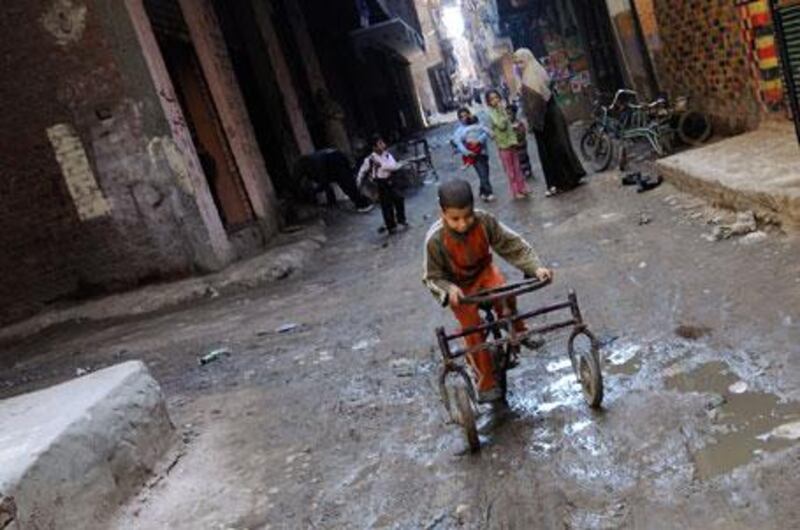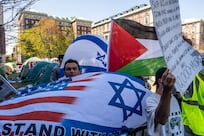As the megacity brims with informal settlements, the upper classes are leapfrogging over the urban perimeter for an escapist paradise of luxury desert property.
Ursula Lindsey
reports.
To drive Cairo's Ring Road - a 110-kilometre freeway that loops the city - is to sail through an endless sea of red brick. The brilliant green of the Nile Valley appears only in flashes through the expanse of cheap apartment blocks. The buildings occupy what were once agricultural parcels; like those parcels, they are long and narrow, with only a hair's breadth of space between them. They crowd right up to the freeway, so close that motorists may glance directly into their bare rooms. From their rooftops sprout unfinished supporting columns - ready for the addition of yet another floor. Their only decoration is bright, mismatched shutters; balconies enlivened by bold geometric patterns - pink and purple lozenges, green and orange stripes; and the bricks that spell, along the upper floors: "Allah."
These are Cairo's slums, what experts call its "informal" or "spontaneous" neighbourhoods. Egyptians call them ashwa'iyat - from the Arabic word for "random", "haphazard". They are the dense, sprawling answer to Cairo's population explosion and its lack of affordable housing. Almost six in 10 Cairenes - at least 10 million people - live in informal neighbourhoods, often with limited access to water, electricity, schools, hospitals or refuse collection, and no real roads.
Most capitals are magnets, but the speed with which the Egyptian one has grown in the last century is testament both to a remarkable centripetal power and to a surrounding vacuum of opportunity. Swelled by waves of rural migration, the population of greater Cairo has gone from less than one million at the beginning of the 20th century to about 18 million today - a megacity in the order of Mumbai or São Paulo, with more people than Lebanon, Jordan and Libya combined.
For centuries, Cairo's expansion has been checked by geography: the city is bounded by a narrow strip of fertile, Nile-irrigated land, with nothing but desert beyond. The migrants who flocked to the city in the last century found there was nowhere to live: they built shacks on rooftops; they made homes out of covered alleys, inner courtyards, and stairwells. Priced out of the soaring formal real estate market, they started building illegally - on the agricultural land that surrounds the city and on the barren plateau that separates it from the desert.
Cairo has long been on the verge of a nervous breakdown. The city teeters under the weight of its multitudes - its public services worn ragged; its air pollution among the worst in the world; its traffic barely managed by freeway overpasses and tunnels, clumsy last-minute bypass surgeries intended to repair its clogged and failing arteries. Faced with the city's barely contained chaos and alarmed by the growing slums, Cairo's elites have begun to dream of escape. Along the Ring Road, billboards advertise exclusive new private developments, with names like country clubs or bad discos - Utopia, Le Reve, Dreamland, Qattamiya Heights, Palm Hills, Belle Ville - and slogans like ""The Egypt of My Desires." One advertisement, overlooking dilapidated buildings in the centre of town, simply asks: "Why Are You Here?"
Cairo's future, it seems, lies outside the city's boundaries, in the desert - where it can be built from scratch. Today the outer edges of the city are one vast construction site, full of subdivisions where empty million-dollar villas stand among the sand dunes, and giant gated communities that promise a luxurious escape from Cairo's pollution and friction. What will be the effect of this flight on the city that's left behind? If Cairo's future is uncertain, its present is no easier to comprehend. "Perhaps today's greatest riddle is not so much 'Where is Cairo headed?'", notes the writer Maria Golia, "as 'Where is Cairo at all?'"
Somewhere between the dirt alleys of the slums and the golf courses of the gated suburbs; between the resourcefulness of millions of poor residents and the real estate speculation that has redefined the city's edges; between the fears that Cairo is becoming one giant "slum" and the fantasy of starting over - the Egyptian capital is taking shape once again.
Hoda Hanin, a 26-year-old teaching assistant, balances her six-month-old daughter on her hip as she heads down a narrow dirt alley to her parents' home in the slum of Bashteel. She grew up here, back when it was a village on the western bank of the Nile. "It was all farmland," she says, "then people started clearing it out, selling the land, building homes for their kids." Today, Bashteel and numerous other nearby villages have been absorbed into the crowded informal neighbourhood of Imbaba. The average density in Cairo is 90,000 people per square mile; in Imbaba, it's over 200,000, three times that of Manhattan. Imbaba's side-streets are unpaved and no more than two metres wide: narrow, endless crevasses between the red-brick buildings. Three-wheel tuk-tuks, imported from India, are the only vehicles capable of navigating the bumpy, rubbish-strewn paths. For decades, the Egyptian government willfully ignored the spread of the ashwa'iyat. The low-level officials who were supposed to enforce zoning and building laws took bribes to look the other way; on official maps of Cairo, these areas simply didn't exist. Under this regime of collusion and neglect, the slums grew and grew, providing the masses much-needed cheap housing and allowing the authorities to forgo providing services.
By the early 1990s, however, Cairo was forced to face its slums. The earthquake that struck the city in 1992 left thousands in the informal neighbourhoods homeless; since then fires and collapses have regularly put one slum or another on the front pages of local newspapers. At around the same time, the Islamist group Jama'a Islamiya took de facto control of Imbaba - creating what the foreign press quickly dubbed "the Islamic Republic of Imbaba". The government dispatched more than 12,000 soldiers to carry out a six-week siege, round up the Islamists, and reimpose its authority.
After regaining control of Imbaba, the government announced it would spend hundreds of millions of Egyptian pounds to - as one newspaper put it - "Transform Centers of Terrorism into a Civilised Area". The government set aside LE600 million (about $200m, or Dh402m) for slum upgrades, demolitions and relocations, and further plans for Imbaba are under way - to create more public housing, relocate thousands of street vendors, demolish some buildings and cut major new thoroughfares through the area.
Hoda thinks new, wider roads would be a great improvement. But like many residents here, her complaints about lack of services are tempered by her pride in how successfully, and civilly, Imbaba manages its own affairs. "The people here are real," she says, "they're good, country people." When on our way home we become stuck in traffic in one of Imbaba's many impassable intersections, she points to the neighbourhood men who are volunteering as impromptu traffic police: "See how they drop everything to help out." When I ask Hoda where else she might like to live, her eyes grow wide and she says emphatically: "No, no, no! I never want to live outside Imbaba. I know the people here. We're used to each other."
"The people in my street let you take pictures there because they trust that I won't let anyone give Imbaba a bad name," Hoda tells me, after my visit. "What will you write about Imbaba? Will you write good things?" Her anxiety over how her neighbourhood will be depicted by outsiders isn't surprising, given the tenor of most discussions of the ashwa'iyat. Hand-wringing over Cairo's slums has become a favourite habit of Egypt's policymakers, artists and public intellectuals. The Egyptian and pan-Arab press abounds with horrified descriptions of these supposedly irredeemable hellholes. An article in Dar Al Hayat newspaper offers a description that is typical in its tone of Victorian shock: the ashwai'yat, the author writes, "are neighbourhoods with no laws and no values and no fixed sources of livelihood - They are neighbourhoods with no peace and security, where crime, selling and taking drugs, prostitution, wanton sex from a young age, take place. Relations are stamped with gangsterism, fighting, revenge, and violence. It's a life without hope, vision, conviction, or the ability to change one's destiny."
More sympathetic depictions of the ashwa'iyat are often no less voyeuristic. A blockbuster 2007 film set in the slums, Hena Maysara, tells the melodramatic story of star-crossed lovers named Nahed and Adel; by the end of the film, Adel has become a gangster, Nahed a prostitute; their illegitimate child becomes a homeless teenage grifter. The slum they inhabit, taken over by extremists, is blown to smithereens in a fiery battle with the police.
The director, Khaled Youssef, called the film "a warning cry", but in scene after titillating scene of sex, violence and drug use, it gives the impression that the ashwai'yat don't contain a single law-abiding, gainfully employed resident. The Egyptian Ministry of Housing estimates there are 67 informal areas in Cairo. They range from truly dismal slums to lower-class neighbourhoods that are dense and under-serviced, but hardly dens of vice and desperation. Yet even as they use the ashwai'yat to mount a critique of the Mubarak government, many artists and intellectuals end up stigmatising these areas as dark, dangerous, and radically different places, which threaten the city's supposed order and culture.
"It's impossible to distinguish between what's ashwa'i and what's not, in Cairo," says Hamdi Abu Golayyel. Abu Golayyel lived in the slum of Manshiyat Nasr for six years, and described it as "a mongrel place, part village and part unplanned city fringe, destination of squatters and incomers" in his 2006 novel Thieves in Retirement. Abu Golayyel and I head there one night, in a taxi that speeds, for almost an hour and half, south along the Nile. Manshiyat Nasr ("Nasser's New Town") is in the industrial suburb of Helwan. It started as public housing for the workers in the nearby state-owned cement factories; but it soon overflowed into the surrounding countryside. A patch of palm trees, stranded between apartment buildings, conjures the fields that stood here just a few decades ago.
Abu Golayyel paid LE 100 a month (about $30, or Dh67 at the time) during his stay there, from 1995 to 2001. He waves towards the stocky little buildings, the small doors and cramped stairwells - these are "living spaces in the most basic sense," he says. "Spaces to eat and sleep." Manshiyat Nasr is a new slum, and it lacks Imbaba's self-confidence and cohesiveness. Abu Golayyel's sly, satirical novel depicts a world in which every basis for community is frayed and unstable. But in his novel the slum isn't the anti-city - it's the essence of the city.
"I don't understand what critics mean by the word 'marginalised,'" says Abu Golayyel, as we leave Manshiyat Nasr. He gestures around him: "This neighbourhood isn't any more marginalised than the rest of the city. People in Midan Tahrir," he says, mentioning Cairo's central square, "have no more power to make political decisions than people here. Mubarak is the core, and the rest of us are all marginalised."
"It's the future," the salesman beside me says matter-of-factly, as we drive across a grey and empty desert plateau, 40km outside Cairo. We've finally reached the outer edge of the seemingly endless belt of construction that surrounds the city. Here lies Madinaty ("My city"), an enormous planned gated community, the brainchild of the disgraced tycoon Talaat Mustafa - once close to the Mubarak family, now appealing a death sentence for the hit he ordered on his Lebanese pop singer girlfriend. Madinaty is designed to house 500,000 people, as well as hospitals, universities, malls and a water park. The developer's website calls it "the biggest all-inclusive enclosed city in the Middle East." Renditions of the city feature palm-dotted lawns, man-made lagoons, glistening office towers, spotless shopping arcades.
The Egyptian government has long been convinced - since the early 1960s - that the solution to Cairo's ills lie in expansion beyond its borders. Back then, however, it was the government that did the developing, erecting a series of self-sufficient blue-collar desert cities that drew disproportionate subsidies but attracted few residents. In line with Egypt's latter-day rapprochement with capitalism, the Mubarak government has taken a drastically different approach, turning over the colonisation of the desert to the forces of private enterprise, selling off vast swaths of state land to developers.
Frenzied real-estate speculation has continued to drive development on Cairo's outskirts: houses and apartments in the new cities are sold and resold many times over before they're even built. My salesman, it turns out, lives in another new development called Dreamland, but he also bought an apartment in Madinaty "as an investment"; in the few years since his purchase, it has already doubled in value. So many people have purchased "investment" properties that, in a city with a severe housing shortage, an estimated million apartments sit empty.
We pass the security checkpoint and enter Madinaty's endless, sweeping driveway. Its main gate is the size of the Arc de Triomphe. The architecture of the duplexes, town houses and apartment buildings inside is internationally bland and rigidly repetitive: red-tiled gables, sun patios, sliding glass doors. The two-bedroom apartments here will set you back Dh370,000; the grand and bland villas cost close to a Dh3.7m.
But what's here so far is nothing compared to what is coming. I look out towards the horizon at a construction site the size of, well, a small city - row upon row of buildings, rising from the sand like a pastel mirage. The salesman notes the clean, bracing breeze. Madinaty is on a desert plateau, almost 300 metres above Cairo. Water from the Nile will have to be pumped all the way up and out here - as to all the new cities - by state-built infrastructure. Electricity and roads - a second ring road is now being planned - will also be provided by the New Urban Communities Administration, which has just issued an LE 10bn (Dh6.7bn) bond to fund its efforts.
Relocating Cairo's wealthier residents will not alleviate the crowding and poverty they leave behind. Though Imbaba has now been "pacified", across enormous tranches of the city the state is still regarded as an unwelcome interloper, and anger is never far from the surface. When a cliff collapsed in the dismal slum of Duwaiqa, in 2008, killing 60 people and destroying 35 houses, emergency vehicles took hours to arrive. The authorities seemed more concerned with sealing off the area to journalists and aid workers than helping distraught residents who had been digging for their relatives with their bare hands. Then bulldozers arrived to demolish 1,000 homes at risk of collapse. Furious residents threw volleys of stones at the bulldozers and the governor's convoy. They compared themselves to Palestinians under Israeli occupation. One columnist in an opposition newspaper wrote of "The Intifada of the ashwa'iyat".
The new enclaves in the desert promise protection from such tensions. A friend knows a lady who bought a home in one of the new private developments. Her house was in the outer row, not far from a nearby public housing project. She decided to switch to a house nearer the centre - because, she said, "when those people rise up," she didn't want to be in the front line.
The slums are most often referred to as a "cancer" - and by that analogy, Cairo is already a terminal case. And the better off residents of this supposedly dying city have embraced the new developments as a sort of miracle cure. I catch a glimpse of their enthusiasm at a five-star hotel overlooking the Nile, where a fashionable crowd - the men in suits, the women in slinky black dresses, not a headscarf in sight - nibbles on canapés while a jazz band plays in the background. I'm attending a reception organised by the real-estate developers SODIC and SOLIDERE to promote their new development, WestTown, located in the desert on the opposite side of Cairo from Madinaty.
I ask a salesman if business has slowed due to the global recession. He assures me that almost all the 175 units on sale - high-end apartments with whirlpools and teak floors, which can be customised in one of three styles: "Urban Chic," "Natural Zen" and "Modern Islamic" - have been snapped up. Guests take turns huddling around a maquette of the development. A projector has been mounted on the ceiling above, to create little virtual future residents, driving their cars down traffic-free, palm-lined streets, eating lunch in the cafes of the (closed-circuit-TV-monitored) plaza and diving into the rooftop pools. It is a projection of a perfect life, and it could be taking place anywhere.
Such pristine, self-sufficient communities are in fact a global phenomenon. But in a city where until recently everyone has been forced to endure close quarters, it is a new development. If, in the next few decades, the enclaves in the desert are populated by Cairo's upper classes, this will represent what one expert on the Egyptian capital calls "a radical reformulation of Cairo's urban landscape."
Modern Cairo came into being, 150 years ago, with another "reformulation", one that bears some striking resemblances to what's going on today. In the 1860s, Egypt's ruler, Khedive Ismail, grafted a European façade onto his capital, hoping to impress the foreign dignitaries invited to the opening ceremonies of the Suez Canal. A western downtown, complete with an opera house, public gardens, and wide Parisian-style avenues, was erected in the span of a few frantic years.
Ironically, the cost of these public works contributed to Egypt's bankruptcy and led to the 70-year-long British occupation that would follow. Ismail showed off, then lost the country; but the district he established flourished, attracting the upper classes and the first modern government services. The nearby medieval core of the city, meanwhile, was increasingly seen as a dirty, disorderly relic of the past.
For most of the 20th century, the fault line between these two worlds - foreign and local, modern and "backward", rich and poor - dominated the real and imaginative landscape of the city. What the anthropologist Janet Abu Lughod has called the "rent in the social fabric" of Cairo featured prominently in work of great Egyptian writers such as Naguib Mahfouz and Youssef Idris. But in 20th-century Cairo, the new and the old city were contiguous, and crossing from one to the other was a fraught but relatively common journey. Today, as spatial segregation and social inequality increase, a much greater chasm seems to be opening.
Or perhaps it would be better described as a vacuum, for Cairo risks becoming a city where no one belongs - a place where the lower classes are blamed for their own disenfranchisement, and from which the upper classes are eager to secede. The preoccupation with the slums shows the malaise most Cairenes feel over the way their city has drifted, seemingly rudderless, over the last half-century. To stigmatise the ashwai'yat for their poverty and their supposed chaos is politically convenient, but to bemoan them as the apocalyptic end of Egypt's urban civilisation is far-fetched. The slums of Cairo are the visible symptoms of the shortage and misdirection of Egypt's resources, of the limits of public oversight, interest and authority. They're the best that most of Cairo's residents - left largely to their own devices - have been able to come up with.
The fantasy that leads into the desert and the hysteria over the slums are two sides of the same coin, each one the sign of a deep unease over Cairo's future and a desire to avoid confronting its present. In the escapism of the gated cities and the horror over the ragged lower-class neighborhoods, after all, there is the same whiff of denial - of a city eager, at least for the time being, to stick its head in the sand.
Ursula Lindsey is a freelance journalist based in Cairo, and writes the culture blog The Arabist Review.





